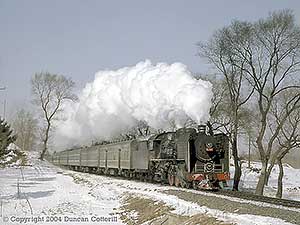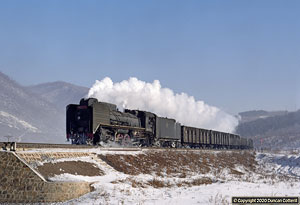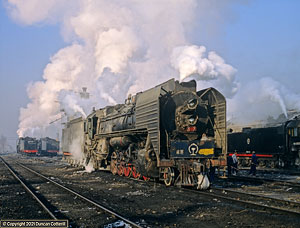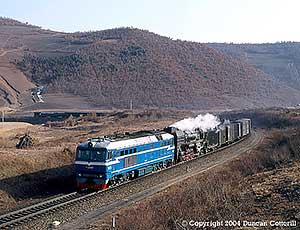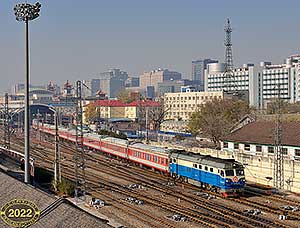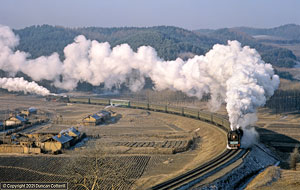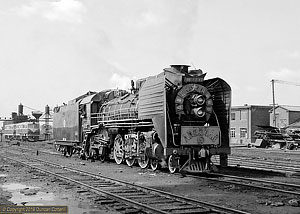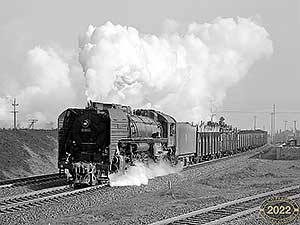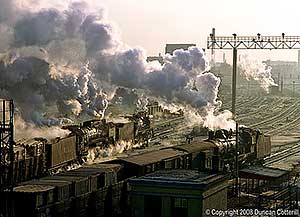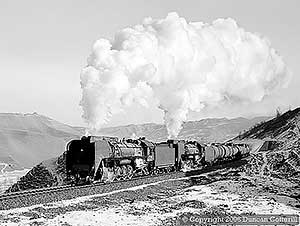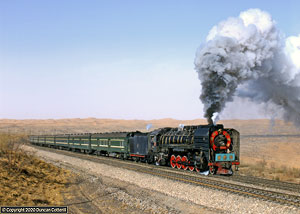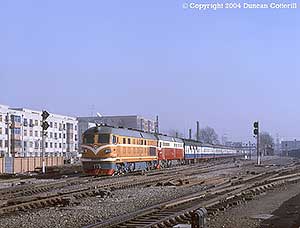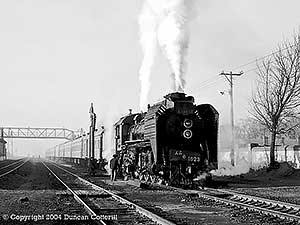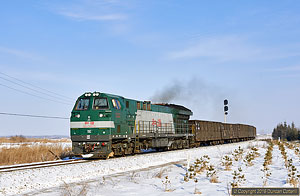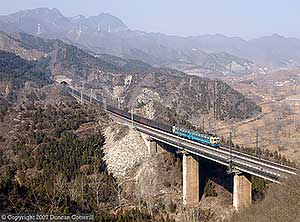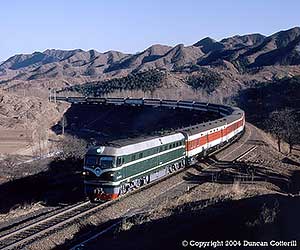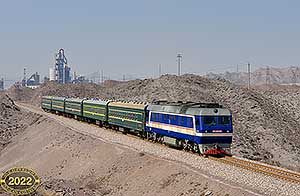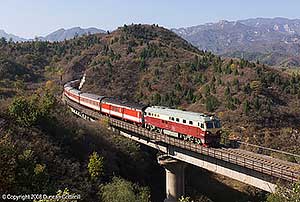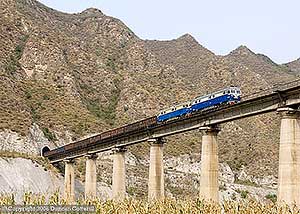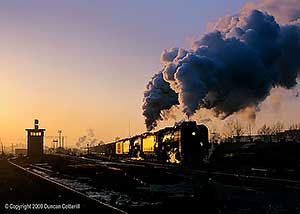Shenyang Bureau : Jilin Area
40 photos
updated : 2024-04-20
Jilin is an industrial city on the Songhua River and an important railway junction. Its petro-chemical plants generate much of the area's freight traffic but it was the SL6 Pacifics that drew us there in the late 1980s. Jilin had the last operational examples of the class and kept them in excellent condition until the end.
Shenyang Bureau : Tonghua Area
36 photos
updated : 2022-12-03
The network around Tonghua was built to take Chinese coal and minerals to the Korean ports to fuel Japan's war effort. This is a very attractive part of China with wooded hills and picturesque river valleys and provided the perfect setting to photograph steam locos in the 1990s and diesels a decade later.
Hohhot Bureau : Baotou Area
26 photos
updated : 2022-11-24
Baotou is Inner Mongolia's second city and an major industrial and steelmaking centre on the Yellow River. It was a division point on the long main line from Datong to Lanzhou with a depot full of QJs. JSs worked the suburban service and the scenic branch to Shiguai. Steam finally finished around 2001.
Harbin Bureau : Mudanjiang Area
23 photos
updated : 2022-11-24
In the Mudanjiang and Jixi areas of Heilongjiang freight traffic is dominated by coal from mines in the Jixi area, which travels via Mudanjiang on its way to Harbin or beyond. In the early 1990s QJs were dominant but they were later ousted by the distinctive DF8 Class diesels and different varieties of DF4.
Beijing Bureau : Beijing City
39 photos
updated : 2022-11-06
China's capital city dispatches trains to all corners of this vast country, worked by a great variety of loco classes. Photography around Beijing isn't easy but there are a few good vantage points, including the Dongnan Jialou, an ancient watchtower that overlooks the exit from the main station.
Harbin Bureau : Nancha Area
41 photos
updated : 2021-07-05
Nancha was a division point on the main line from Harbin to Jiamusi and the junction for a 257km branch into the northern forests. Freight traffic was heavy and all steam worked until the mid 1990s. Less important passengers were RM or JS hauled in the 1980s before QJs and then diesels took over.
Harbin Bureau : Jiamusi Area
8 photos
updated : 2021-07-05
Jiamusi is a railway junction in the far north-east of China, close to the Russian border. In the late 1980s the depot's allocation consisted mainly of QJ Class 2-10-2s to work the heavy coal traffic to the west. There were also a number of RM Class 4-6-2s to work passengers. These photos were taken in 1988.
Shenyang Bureau : Changchun Area
46 photos
updated : 2021-03-22
Changchun is one of north-east China's major rail hubs, where the main line from Harbin to Shenyang meets secondary routes from Jilin and Baicheng. In the mid 1980s it was a steam fan's paradise with QJs on freight, SL and RM Pacifics on passengers and JFs on the shunts. It wasn't long before the diesels took over.
Harbin Bureau : Harbin Area
25 photos
updated : 2020-11-20
Harbin is the capital of Heilongjiang Province and one of the main rail centres in north-east China. In the mid-1980s steam worked everything apart from a few expresses but the diesels soon took over much of the freight. This gallery contains pictures taken in the 1980s and in 2006.
Lanzhou Bureau : Lanzhou - Wuweinan
23 photos
updated : 2020-11-15
The Lanzhou - Wuweinan line is a vital link to China's north-west and carries heavy traffic. Southbound trains faced a 50km climb at 1 in 50 to Wushaoling summit, almost 10,000ft above sea level. The line was electrified in the early 1990s and the summit section closed after a base tunnel was opened in 2006.
Lanzhou Bureau : Zhongwei - Gantang
19 photos
updated : 2020-11-13
The Zhongwei - Gantang line is part of the long route from Beijing to Lanzhou via Inner Mongolia. Westbound trains climb at 1 in 80 for 60km from the Yellow River valley onto the edge of the Gobi Desert. It was a spectacular place to see double and sometimes triple headed QJs hard at work in the early 1990s.
Shenyang Bureau : Shenyang Area
14 photos
updated : 2020-11-12
Shenyang is at the junction of three major rail routes, south-west to Beijing, south to Dalian and north to Harbin, as well as secondary lines to Fuxin, Jilin and Dandong. It was very busy for both passenger and freight traffic and steam lasted until the late 1990s although the best of it had gone five years earlier.
Shenyang Bureau : Jinzhou Area
4 photos
updated : 2020-11-12
JInzhou is a medium sized city, 242km west of Shenyang on the main line towards Beijing. It was a division point in steam days, where trains on the main line changed engines, and the junction of the line north to Yiyian. These photos were taken when passing through the area or visiting nearby industrial lines.
Harbin Bureau : Haila'er Area
5 photos
updated : 2019-10-11
This is the far north of Inner Mongolia, which is actually the northernmost part of China, bordering Siberia and with a climate to match. The pictures here were taken during visits to industrial lines in the area long after the end of main line steam working and feature a range of diesel classes.
Beijing Bureau : DaQin Coal Line
6 photos
updated : 2019-10-11
This busy electrified freight line was built in the late 1980s to move coal from the Datong coalfield to Qinhuangdao port. In order to avoid the Beijing city area, it runs through the mountains to the north, using a succession of bridges and tunnels to conquer the difficult terrain. Trains are heavy and frequent.
Beijing Bureau : Chengde - Miyun
8 photos
updated : 2017-03-09
The line from Chengde to Miyun, near Beijing wasn't particularly busy but it was very scenic and most freight remained steam worked until the mid 1990s. Only a short drive from Beijing Airport, it was the ideal first destination after arriving in the country. This gallery only contains diesels at the moment.
Lanzhou Bureau : Baiyin Area
9 photos
updated : 2016-07-16
Baiyin is home to an interesting industrial railway system connected to a long branch that leaves the Lanzhou - Zhongwei main line at Baiyin Xi and runs east for 114km to Honghui. These pictures of diesel hauled trains on the branch were taken during gaps in traffic on the industrial railway.
Beijing Bureau : Beijing - Longhua
12 photos
updated : 2016-07-16
The Longhua line is part of a direct Beijing - Chifeng - Tongliao route built in the 1970s and opened in 1981. It has many long tunnels and may well have been diesel worked from the start. There's some excellent scenery on the Beijing - Longhua section as can be seen from the images here.
Beijing Bureau : Beijing - Taiyuan
10 photos
updated : 2016-07-16
The line from Beijing to Taiyuan has to cross a range of mountains immediately west of Beijing and does so by following the spectacular Juma River Valley with many bridges, tunnels and superb photo locations, particularly around Shidu, a small resort town popular with the locals. These photos were taken in 2006.
Harbin Bureau : Bei'an Area
21 photos
updated : 2016-07-16
Bei'an is off the beaten track in the north of Heilongjiang but in 1999 it was one of the last strongholds of main line steam with some very well looked after QJ and JS. In 2008 it was the Heihe Local Railway's DFs that attracted me back only to find that they had recently been replaced by DF4s.
It's difficult to comprehend the scale of China's railway system or the speed with which it's changed over the last few decades. The photos here are the result of dozens of visits to main line and industrial locations across the country since 1984 and depict many classes of steam, diesel and electric loco at work.




 options
options hide options panel
hide options panel